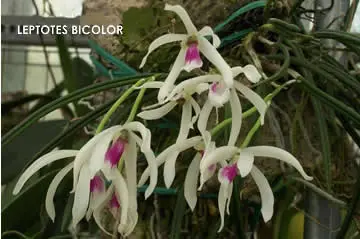 |
||
| Eria
500 or so species make up this genus which is distributed from China to the south Pacific islands. It is related to Dendrobium but many have pseudobulbs instead of canes. Can be mounted on bark or hanging baskets. These plants like a short rest after the growth cycle. |
||
| Leptotes bicolor | ||
| /\ Top of Page | ||
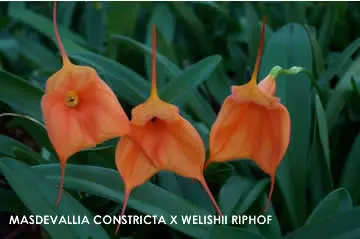 |
||
| Masdevallia A genus of around 350 species found from Mexico down to Brazil. They grow as ephiphytes quite high up in the Andes, so they like cool damp conditions. The flowers are extremely showy and they are fast growers, needing repotted every 2 years.more |
||
| Masdevallia constricta x welischii | ||
| /\ Top of Page | ||
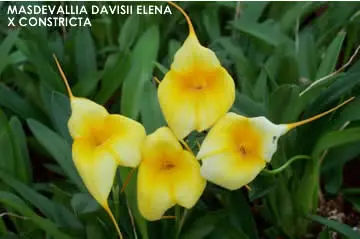 |
||
| Masdevallia A genus of around 350 species found from Mexico down to Brazil. They grow as ephiphytes quite high up in the Andes, so they like cool damp conditions. The flowers are extremely showy and they are fast growers, needing repotted every 2 years.more |
||
| Masdevallia davisii elena x constricta | ||
| /\ Top of Page | ||
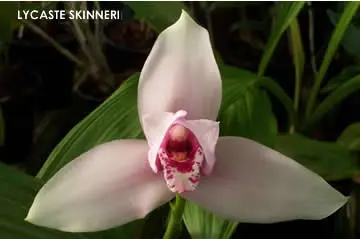 |
||
| Lycaste
Found throughout latin america, there are 45 species of this genus. The plants are ephiphytes with small pseudobulbs and 2 to 4 leaves. |
||
| Lycaste skinneri | ||
| /\ Top of Page | ||
 |
||
| Lycaste
Found throughout latin america, there are 45 species of this genus. The plants are ephiphytes with small pseudobulbs and 2 to 4 leaves. |
||
| Lycaste lasioglossa x skinneri | ||
| /\ Top of Page | ||
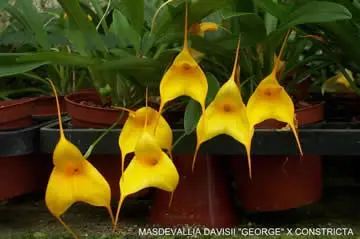 |
||
| Masdevallia A genus of around 350 species found from Mexico down to Brazil. They grow as ephiphytes quite high up in the Andes, so they like cool damp conditions. The flowers are extremely showy and they are fast growers, needing repotted every 2 years.more |
||
| Masdevallia davisii george x constricta | ||
| /\ Top of Page | ||
 |
||
| Masdevallia A genus of around 350 species found from Mexico down to Brazil. They grow as ephiphytes quite high up in the Andes, so they like cool damp conditions. The flowers are extremely showy and they are fast growers, needing repotted every 2 years.more |
||
| Masdevallia floribunda galleottiana | ||
| /\ Top of Page | ||
 |
||
| Maxillaria
This genus from the americas is almost 700 strong and is found in Florida all the way down to Argentina. Most are ephiphytes that like intermediate conditions. They have pseudobulbs with 1 to 4 leaves. Flowers are produced singly from the base of the pseudobulbs. Watering should be continued throughout the year. |
||
| Maxillaria brunnea | ||
| /\ Top of Page | ||
 |
||
| Maxillaria
This genus from the americas is almost 700 strong and is found in Florida all the way down to Argentina. Most are ephiphytes that like intermediate conditions. They have pseudobulbs with 1 to 4 leaves. Flowers are produced singly from the base of the pseudobulbs. Watering should be continued throughout the year. |
||
| Maxillaria chrysantha | ||
| /\ Top of Page | ||
 |
||
| Maxillaria
This genus from the americas is almost 700 strong and is found in Florida all the way down to Argentina. Most are ephiphytes that like intermediate conditions. They have pseudobulbs with 1 to 4 leaves. Flowers are produced singly from the base of the pseudobulbs. Watering should be continued throughout the year. |
||
| Maxillaria crassifolia | ||
| /\ Top of Page | ||
 |
||
| Maxillaria
This genus from the americas is almost 700 strong and is found in Florida all the way down to Argentina. Most are ephiphytes that like intermediate conditions. They have pseudobulbs with 1 to 4 leaves. Flowers are produced singly from the base of the pseudobulbs. Watering should be continued throughout the year. |
||
| Maxillaria ochroleuca | ||
| /\ Top of Page | ||
 |
||
| Maxillaria
This genus from the americas is almost 700 strong and is found in Florida all the way down to Argentina. Most are ephiphytes that like intermediate conditions. They have pseudobulbs with 1 to 4 leaves. Flowers are produced singly from the base of the pseudobulbs. Watering should be continued throughout the year. |
||
| Maxillaria phorphyrostele | ||
| /\ Top of Page | ||
 |
||
| Maxillaria
This genus from the americas is almost 700 strong and is found in Florida all the way down to Argentina. Most are ephiphytes that like intermediate conditions. They have pseudobulbs with 1 to 4 leaves. Flowers are produced singly from the base of the pseudobulbs. Watering should be continued throughout the year. |
||
| Maxillaria praestans | ||
| /\ Top of Page | ||
 |
||
| Maxillaria
This genus from the americas is almost 700 strong and is found in Florida all the way down to Argentina. Most are ephiphytes that like intermediate conditions. They have pseudobulbs with 1 to 4 leaves. Flowers are produced singly from the base of the pseudobulbs. Watering should be continued throughout the year. |
||
| Maxillaria rufescens | ||
| /\ Top of Page | ||
 |
||
| Maxillaria
This genus from the americas is almost 700 strong and is found in Florida all the way down to Argentina. Most are ephiphytes that like intermediate conditions. They have pseudobulbs with 1 to 4 leaves. Flowers are produced singly from the base of the pseudobulbs. Watering should be continued throughout the year. |
||
| Maxillaria splendens | ||
| /\ Top of Page | ||
 |
||
| Maxillaria
This genus from the americas is almost 700 strong and is found in Florida all the way down to Argentina. Most are ephiphytes that like intermediate conditions. They have pseudobulbs with 1 to 4 leaves. Flowers are produced singly from the base of the pseudobulbs. Watering should be continued throughout the year. |
||
| Maxillaria tenuifolia | ||
| /\ Top of Page | ||
 |
||
| Micropera An asian genus ranging from India to Australia, there are 15 species of these monopodial ephiphytes. They like intermediate to warm conditions with uniform wtering all year round. |
||
| Micropera apiculata | ||
| /\ Top of Page | ||
 |
||
| Miltonia
A genus of 10 species from Brazil. They have pseudobulbs with 1 or 2 leaves, the flowers appear at axils of the sheaths. The flowers do not have a spur, the sepals and petals are separate and the lip is large and flat. |
||
| Miltonia flavescens | ||
| /\ Top of Page | ||
 |
||
| Miltonia
A genus of 10 species from Brazil. They have pseudobulbs with 1 or 2 leaves, the flowers appear at axils of the sheaths. The flowers do not have a spur, the sepals and petals are separate and the lip is large and flat. |
||
| Miltonia regnellii | ||
| /\ Top of Page | ||
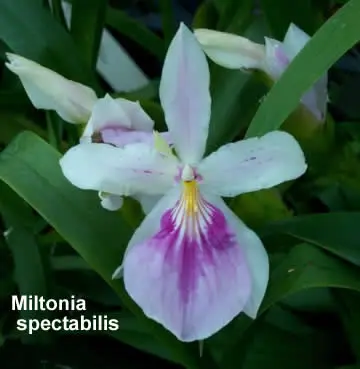 |
||
| Miltonia
A genus of 10 species from Brazil. They have pseudobulbs with 1 or 2 leaves, the flowers appear at axils of the sheaths. The flowers do not have a spur, the sepals and petals are separate and the lip is large and flat. |
||
| Miltonia spectabilis | ||
| /\ Top of Page | ||
 |
||
| Miltonia
A genus of 10 species from Brazil. They have pseudobulbs with 1 or 2 leaves, the flowers appear at axils of the sheaths. The flowers do not have a spur, the sepals and petals are separate and the lip is large and flat. |
||
| Miltonia spectabilis morelliana | ||
| /\ Top of Page | ||